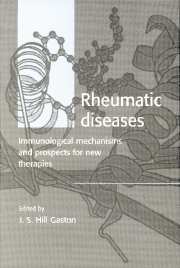Book contents
- Frontmatter
- Contents
- List of contributors
- 1 Implications of advances in immunology for understanding the pathogenesis and treatment of rheumatic disease
- 2 The role of T cells in autoimmune disease
- 3 The role of MHC antigens in autoimmunity
- 4 B cells: formation and structure of autoantibodies
- 5 The role of CD40 in immune responses
- 6 Manipulation of the T cell immune system via CD28 and CTLA-4
- 7 Lymphocyte antigen receptor signal transduction
- 8 The role of adhesion mechanisms in inflammation
- 9 The regulation of apoptosis in the rheumatic disorders
- 10 The role of monokines in arthritis
- 11 T lymphocyte subsets in relation to autoimmune disease
- 12 Complement receptors
- Index
3 - The role of MHC antigens in autoimmunity
Published online by Cambridge University Press: 06 September 2009
- Frontmatter
- Contents
- List of contributors
- 1 Implications of advances in immunology for understanding the pathogenesis and treatment of rheumatic disease
- 2 The role of T cells in autoimmune disease
- 3 The role of MHC antigens in autoimmunity
- 4 B cells: formation and structure of autoantibodies
- 5 The role of CD40 in immune responses
- 6 Manipulation of the T cell immune system via CD28 and CTLA-4
- 7 Lymphocyte antigen receptor signal transduction
- 8 The role of adhesion mechanisms in inflammation
- 9 The regulation of apoptosis in the rheumatic disorders
- 10 The role of monokines in arthritis
- 11 T lymphocyte subsets in relation to autoimmune disease
- 12 Complement receptors
- Index
Summary
Introduction
The immunological basis for autoimmune disease is complex, and autoimmune diseases themselves are diverse in character. The pathogenesis of specific autoimmune diseases may well be different, involving both genetic and environmental factors. However, many autoimmune diseases share an association with the HLA locus and, more specifically, the highly polymorphic class I and class II alleles found in this region. Recent advances in the understanding of the structure and function of HLA class I and class II molecules have made it possible to begin to decipher mechanisms by which these genes may be contributing to the development of autoimmunity. In this chapter, we will address the evidence that the HLA locus is associated with autoimmunity, the possible mechanisms by which HLA genes could contribute to disease, and the implication that this information will have on future assessment and treatment of patients with autoimmune diseases.
The HLA locus
The HLA locus is a cluster of genes found on chromosome 6 (6p21.3). This region includes the genes encoding HLA class I and class II proteins, complement and other factors important in the generation of the immune response. Figure 3.1 demonstrates the distribution of genes across this region. The HLA class I genes are located at the telomeric end of the human MHC. The HLA-A, HLA-B and HLA-C loci are referred to as class I genes and encode the principle transplantation antigens, which are expressed in all nucleated cells. The class I genes each encode a single polypeptide, the HLA class I heavy chain. The class I heavy chain forms a complex with β2–microglobulin, a protein encoded outside of the MHC region, to form the functional HLA class I molecule.
- Type
- Chapter
- Information
- Rheumatic DiseasesImmunological Mechanisms and Prospects for New Therapies, pp. 33 - 60Publisher: Cambridge University PressPrint publication year: 1999



